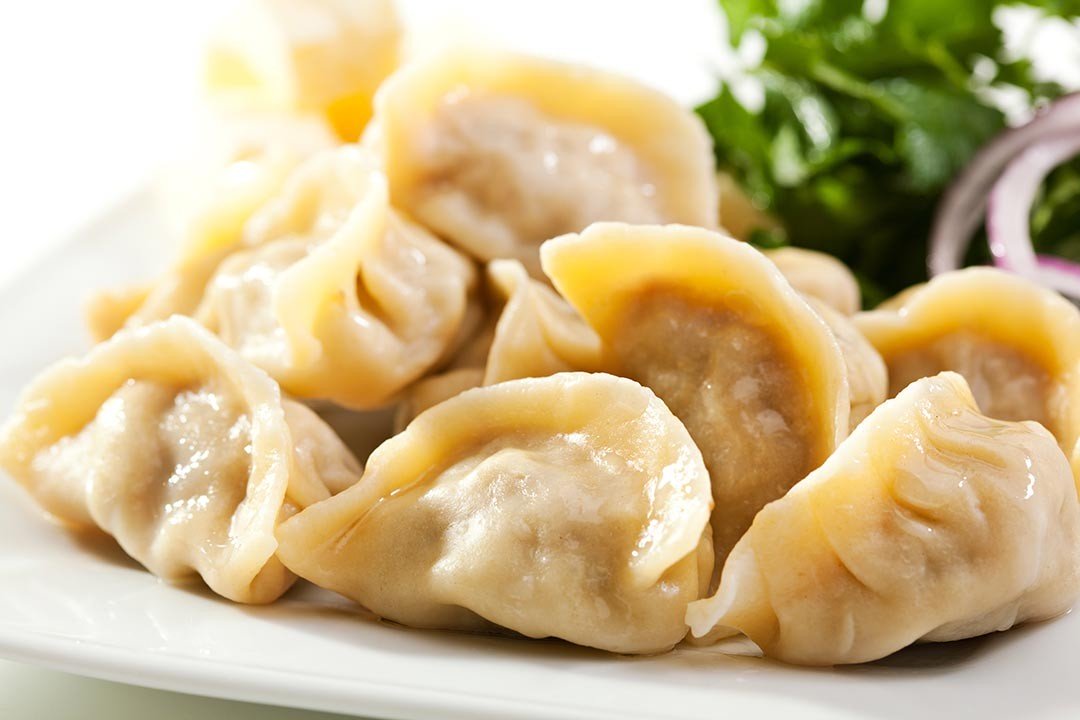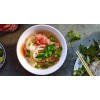The Art of Chinese Dumplings
Jiaozi are a kind of Chinese dumpling, commonly eaten in China and other parts of East Asia. They are one of the major foods eaten during the Chinese New Year and year-round in the northern provinces. Though considered part of Chinese cuisine, jiaozi is popular in other parts of Asia and in Western countries.
Jiaozitypically consists of aground meat filling wrapped into a thinly rolled piece of dough, which is then sealed by pressing the edges together. Finishedjiaozican be boiled (shuǐ jiǎo), steamed (zhēng jiǎo) or pan-fried (jiān jiǎo) and are traditionally served with black vinegar and sesame oil dip.
Fillings:
As a dish prepared at home, each family has its own preferred method of making them, using favorite fillings, with types and methods of preparation varying widely from region to region. Common dumpling meat fillings include pork, mutton, beef, chicken, fish, and shrimp, which are usually mixed with chopped vegetables. Popular vegetable fillings include napa cabbage, scallion(spring onions), leek, celery, spinach, mushroom, edible black fungus, carrot, and garlic chives.
Folding technique:
There are many ways to foldjiaozi. Basically, steps for folding the skin includes putting a single pleat in the middle, putting multiple pleats along the edge, making a wavy edge like a pie crust, turning a pleated edge in toward the body resulting in a rounded edge, and putting both ends together resulting in a round shape. Different shapes of Jiaozi require different folding techniques, but the most famous and common technique is the pinched-edge fold. Take a wrapper and put one tablespoon of filling into the center of the wrapper. Fold half of the edge to the other half. Use left thumb and forefinger to pinch one side of the half-moon wrapper, and then use right thumb to push the inside skin outward, right forefinger to make outside skin into small pleats. Use right thumb to clench those pleats. Repeat these steps to the other side of the wrapper, and make sure to clinch the seal of Jiaozi. This is crescent-shapedjiaozi, the most popular shape in China.
Boiled dumplings are moist and juicy. With a small bite of a dumpling, the hot and flavorful soup will drizzle from the filling. If you’ve ever tried Shanghai soup dumplings (xiao long bao, 小笼包), you know what I’m talking about. The handmade dumpling wrappers are thin, tender, and delicious. The filling is well balanced with meat and vegetable, not too greasy, nice in flavor, and comforting. Everything works perfectly together to create a fulfilling, healthy, and hearty one-dish meal.
Boiled dumplings are also the most important dish for celebrating Chinese (Lunar) New Year in northern China. My family eats them on New Year’s Eve when all the family members are gathered at home. It is a ritual comparable to that of the roast turkey at Thanksgiving.
Things you should take note of:
·Let the dough rest enough. If you don’t have enough time, you can use the dough after it’s rested for 1 hour, at least. But the dough will be smoother and more springy if you let it rest longer.
·Make tougher dough. To make the dough work, it’s better to make it a bit tougher than softer. If the dough is too tough and difficult to roll, let it rest for 3 to 4 hours; it will become soft enough to work with. But if the dough is too soft, it’ll be difficult to wrap and the dumplings won’t keep their shape.
·Move fast once the wrappers are ready. Because they dry out very fast, and it will become difficult to seal the dumplings later. If you work solo, you can make small batches of wrappers (10 to 12) each time and fold the dumplings soon after. Or, you can work as a team. One person can roll the wrappers while the other person simultaneously wraps the dumplings.
·Cook or store the dumplings soon after they’re wrapped. The dumpling filling usually contains liquid from the vegetables, and this will make the finished dumplings moist. But if you let the dumplings sit too long, the moisture will be absorbed by the dough. This will cause the dumplings to fall apart during cooking. What you can do is to freeze each small batch you just wrapped before moving onto the next batch. Cook the frozen dumplings before servings, their texture is as good as the fresh ones.
·Cook dumplings in small batches in a large pot. Cook 20 to 25 dumplings at a time, or fewer if the dumplings are larger, so the dumplings won’t stick to the pot.
·Never take your eyes off the pot when boiling the dumplings. This is the trickiest part. The whole boiling process will be less than 5 minutes. If you leave the dumplings to cook in the water a bit longer than they need, they will start to fall apart. Check the recipe below to see how to make sure the dumplings are cooked just right.
Chinese dumplings recipe/ how to make chinese dumplings
·Prep Time:4 hours
·Cook Time:20 mins
·Yield:70 - 80 dumplings
INGREDIENTS
·500 grams (4 cups / 18 ounces) all-purpose flour (*see footnote 1)
·265 milliliter (1 cup plus 2 tablespoons / 9 ounces) water (room temperature)
·About 4 cups preferable dumpling filling ( refer lamb with vegetables)
INSTRUCTIONS
To prepare the dough
1. Add flour into a large bowl. Slowly pour the water into the bowl, mixing them together with a pair of chopsticks.
2.When the water is mixed with the flour, dust both hands with flour and start kneading to form the dough. The dough will be quite tough and should easily be able to be lifted from the bowl without sticking to the bottom.
3. When the dough has formed, dust the working surface with flour and dust hands again. Transfer the dough to the working surface and continue to knead it until its surface becomes smooth about 10 minutes.
4. Rinse a clean dish towel with water. Dust the bottom of a large bowl with flour and transfer the dough into it. Cover bowl with the damp dish towel and a lid (or plastic wrap). Let the dough rest for 2 hours. You can let the dough rest longer, 4 to 5 hours.
5. After resting, the dough will be softened and have a smooth texture. Dust the working surface and your hands with extra flour and transfer the dough onto the surface. Knead the dough repeatedly for another 3 to 5 minutes, until the dough hardens again. Let the dough rest for about 30 minutes (or longer).
During this time, you can prepare the dumpling filling(s).
To make dumplings
1. Dust the working surface again and transfer the dough onto it. Slice 1/6 of the dough off and place the rest back to the big bowl. Cover it with the damp dish towel.
2. Roll the dough into a long stick, 2.5 to 3 centimeters (1 inch) in diameter. Use a knife to cut the dough stick into about 12 small doughs, each weighing 12 to 14 grams (0.4 to 0.5 oz)
3. Slightly dust both sides of each small dough with flour. Work on them one at a time.
4. Dust the working surface again. Take one dough and press it to a round disc. Roll it with a rolling pin into a round sheet (refer to the video. Try to roll it so that that the edge is thinner than the center. The wrapper should be about 1 millimeter thick (i.e. almost same as the thickness of a CD), and the diameter should be about 7 centimeters. It is ok if the wrapper is not perfectly round.
1. Starting here, you should work as quickly as you can, because the wrappers will dry out quickly. And if they do, you will find it very difficult to seal the dumplings later. If the wrappers dry out when you start to fold the dumplings, brush a bit of water over the edge so you can still seal the dough.
2. Scoop about 1 tablespoon (or less, so you can easily fold the dumpling) of dumpling filling and place it in the center of the wrapper. Hold the dumpling with one hand and start sealing the edges with the other hand (refer to the video to see how to fold a dumpling). Be careful, when you press the edges together to seal the dumpling, do not let filling touch the sealing area (the dumpling will fall apart if you do). After folding, press edge again to seal well. You don’t need to fold beautiful dumplings here; our goal is to make the dumplings hold their shape during boiling.
1. Place the dumplings on the working surface and work on the rest of the doughs in the same manner.
2. Try to wrap and cook dumplings in small batches (20 to 25 dumplings at a time). If you won’t cook dumplings soon after wrapping (within 30 minutes), freeze them first (refer to the session “to store dumpling” below). If you want to know the reason, read the session of “Things you should take note of” above.
To cook boiled dumplings
1. Bring a large pot of water to a boil.
2. Carefully add dumplings one at a time into the water. Use a big ladle to stir the water gently and continuously, until the water starts to boil again, so the dumplings won’t stick to the bottom, for about 1 minute. Adjust the heat so the water is at boiling point, but isn’t bubbling too fiercely.
3. When the dumplings float to the surface, continue boiling until the dumplings are filled with air and swollen, and the dough starts to become transparent, about 1 minute (*see footnote 3). Immediately transfer all the dumplings to a plate.
Be careful, the dumplings cook quickly and you should always stand beside the pot throughout the boiling process. When the dumplings are cooked, they will start to fall apart within seconds, so transfer them as soon as possible.
To cook potstickers
1. Heat a tablespoon of oil in a nonstick skillet over medium-high heat. When the oil is hot, place potstickers in the skillet, pleat side up.
2. Swirl 2 tablespoons water in the skillet, cover immediately and turn the heat to medium. Cook covered until the water is evaporated and potstickers are cooked through 3 to 4 minutes.
3. Remove the cover and flip one potsticker to see whether the bottom side is charred. If not, turn to medium-high heat and cook until the bottom side turns golden brown.
Transfer the potstickers to a plate.
To serve dumplings
00001.Option 1: Serve with Chinese black vinegar and a few ginger slices.
00002.Option 2: Serve with 1 tablespoon Chinese black vinegar + 1 teaspoonlight soy sauce + 1/2 teaspoon sesame oil.
3.Option 3: Serve with Chinese black vinegar and a few dropsfresh Chili oils.
To freeze raw dumplings
1.If you plan to store dumplings or won’t serve them immediately, always freeze them uncooked. It won’t affect the texture or flavor of the dumplings.
2. Dust the bottom of a big airtight box with a thin layer of flour. Place the dumplings, one finger’s width apart. Store in the freezer for up to 2 months.
To cook frozen dumplings
1. Bring a large pot of water to a boil. Add dumplings into the water. Use a big ladle to stir a few times. Cover and cook until the water starts to boil again. Adjust the heat so the water will keep boiling without spilling. Cover and cook for 3 minutes (up to 5 minutes for bigger dumplings). Uncover pot. Continue to cook for about 1 minute (up to 2 minutes for bigger dumplings), until cooked through. Transfer to a plate immediately.
To store and reheat cooked dumplings
1. Store leftover boiled dumplings in an airtight container in the fridge and consume as soon as possible, within 1 to 2 days.
2. To reheat in the microwave – Add dumplings into a bowl and sprinkle with a few drops of water. Cover and heat until warm.
3. To reheat by steaming – Place dumplings in a bowl. Place a tall-rimmed plate upside down in a pot and add water to cover. Place the bowl of dumplings on top. Heat over high heat until water is boiling. Continue cooking for 5 minutes.
4.To pan fry – Grease a nonstick skillet with a thin layer of oil and heat over medium heat. When skillet is hot, add dumplings. Swirl in a tablespoon of water, cover immediately and cook for 2 to 3 minutes.
References:
https://omnivorescookbook.com/recipes/how-to-make-chinese-dumplings
Related Articles
Search
Categories
Popular Posts























Comments: 0
No comments